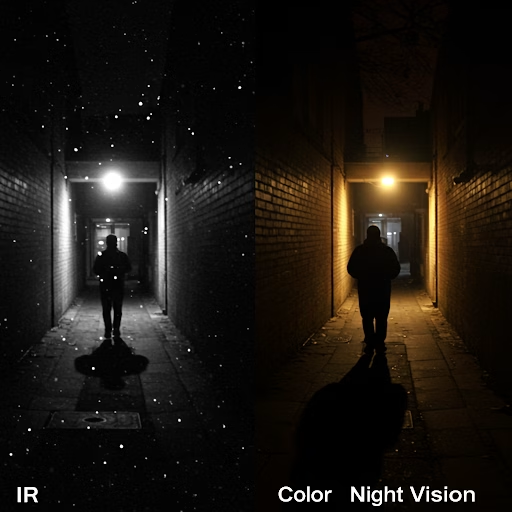IR Night Vision vs Color Night Vision: A Comprehensive Guide
In the realm of security and surveillance, the ability to capture clear and detailed footage in low-light or no-light conditions is paramount. Night vision technology has revolutionized the way we monitor and protect our surroundings, offering a sense of security and peace of mind. Among the various night vision technologies available, IR (infrared) night vision and color night vision stand out as the most prevalent. This blog post aims to delve into the intricacies of these two technologies, comparing their features, advantages, and disadvantages to help you make an informed decision when choosing a security camera or surveillance system. 
Understanding the Basics
Before we dive into the comparison, let’s briefly understand the fundamental principles behind IR and color night vision.
- IR Night Vision:
- IR night vision utilizes infrared light, which is invisible to the human eye, to illuminate the scene.
- Cameras equipped with IR LEDs emit this infrared light, which bounces off objects and is captured by the camera’s sensor.
- The resulting image is typically monochrome (black and white).
- IR night vision utilizes infrared light, which is invisible to the human eye, to illuminate the scene.
- Color Night Vision:
- Color night vision, also known as starlight technology, relies on highly sensitive sensors and advanced image processing to capture color images in low-light conditions.
- These cameras are designed to amplify the available ambient light, allowing them to produce color footage even in dimly lit environments.
- Color night vision, also known as starlight technology, relies on highly sensitive sensors and advanced image processing to capture color images in low-light conditions.
Key Differences
Now, let’s explore the key differences between IR and color night vision:
- Image Output:
- IR night vision produces monochrome images, while color night vision provides color footage.
- Color images offer more detailed and realistic representations of the scene, making it easier to identify objects and individuals.
- IR night vision produces monochrome images, while color night vision provides color footage.
- Light Sensitivity:
- IR night vision can function in complete darkness, as it relies on its own infrared illumination.
- Color night vision requires some level of ambient light to produce color images. In complete darkness, it may switch to monochrome mode or produce very poor image quality.
- IR night vision can function in complete darkness, as it relies on its own infrared illumination.
- Range:
- The range of IR night vision is determined by the power of the IR LEDs.
- Color night vision’s range is limited by the available ambient light.
- Image Detail:
- Color night vision generally provides more detailed images, as it captures color information.
- IR night vision can provide very clear images, but lacks the color information.
- Color night vision generally provides more detailed images, as it captures color information.
- Cost:
- IR night vision cameras are typically more affordable than color night vision cameras.
- Color night vision cameras use more advanced sensor technology, and more advanced processing, so this increases the cost.
Advantages and Disadvantages
To further clarify the distinctions between these technologies, let’s examine their respective advantages and disadvantages:
IR Night Vision:
- Advantages:
- Effective in complete darkness.
- Relatively inexpensive.
- Wide availability.
- Mature technology, so very reliable.
- Disadvantages:
- Monochrome images.
- Limited range.
- IR light can cause glare or overexposure.
- Advantages:
- Color images.
- More detailed footage.
- Better identification of objects and individuals.
- More natural looking footage.
- Disadvantages:
- Requires some ambient light.
- More expensive.
- Can suffer from noise in very low light.
Applications
The choice between IR and color night vision depends on the specific application and requirements.
- IR Night Vision:
- Ideal for applications where complete darkness is expected, such as:
- Perimeter security.
- Warehouses.
- Parking lots.
- Ideal for applications where complete darkness is expected, such as:
- Color Night Vision:
- Suitable for applications where color information is crucial, such as:
- Residential security.
- Retail stores.
- Identifying vehicles.
- Suitable for applications where color information is crucial, such as:
Factors to Consider When Choosing
When selecting a security camera or surveillance system, consider the following factors:
- Lighting Conditions: Assess the typical lighting conditions of the area you wish to monitor.
- Image Quality: Determine the level of detail and color accuracy required.
- Range: Consider the distance you need to cover.
- Budget: Establish a budget and compare the costs of different options.
- Specific Needs: Consider if the footage is going to be used in a court of law. Color footage will be far more useful in this situation.
Conclusion
Both IR and color night vision technologies offer valuable capabilities for security and surveillance. The choice between them depends on the specific needs of the application. IR night vision excels in complete darkness and is a cost-effective solution, while color night vision provides more detailed and realistic footage in low-light conditions. By carefully considering the factors outlined in this blog post, you can make an informed decision and select the night vision technology that best suits your requirements.
Share this:
- Click to share on Facebook (Opens in new window) Facebook
- Click to share on X (Opens in new window) X
- Click to share on WhatsApp (Opens in new window) WhatsApp
- Click to email a link to a friend (Opens in new window) Email
- Click to share on Reddit (Opens in new window) Reddit
- Click to share on LinkedIn (Opens in new window) LinkedIn
- Click to share on Pinterest (Opens in new window) Pinterest
- Click to share on Telegram (Opens in new window) Telegram
Related
Discover more from ChenAnIoT
Subscribe to get the latest posts sent to your email.




